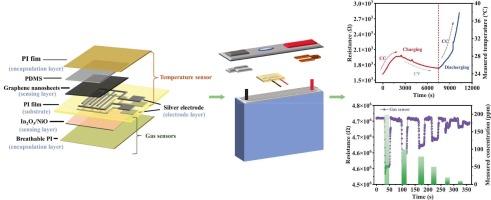In situ monitoring of internal temperature and hydrogen gas evolution in commercial lithium-ion batteries via flexible bifunctional sensors
IF 8.9
2区 工程技术
Q1 ENERGY & FUELS
引用次数: 0
Abstract
Lithium batteries (LIBs) in energy storage plants experience thermal runaway in severe cases due to inconsistent charging and discharging conditions. Traditional external parameter collection is insufficient for a battery management system to achieve a safe and comprehensive assessment. In this study, we propose a method for in-situ monitoring of the internal temperature and H2 within batteries. This method is based on an ultrathin, flexible, bifunctional sensor, which can measure the resistance parameters induced by temperature and gas changes. We construct the temperature and gas sensors on flexible electrodes prepared through microelectronic printing technology. Polyimide films with flexible, breathable, and hydrophobic properties are prepared via electrospinning technology to encapsulate the sensors, which exhibit high thermal-response sensitivity of 0.036 °C−1 and achieve an ultra-fast gas response/recovery time of 3 s/4.2 s. The results of long-term cycling experiments demonstrate that this thin-film sensor can efficiently monitor the internal temperature changes of batteries at different rates in real time, and it is capable of long term in-situ detection of H2 under actual working conditions. Throughout the entire monitoring process, the influence of the sensor on battery performance is almost negligible. This method provides a new approach for the detectability of smart LIBs and early warning of thermal runaway, contributing to the intelligent management of LIBs.

利用柔性双功能传感器对商用锂离子电池内部温度和氢气析出进行现场监测
由于充放电条件不一致,储能装置中的锂电池在严重情况下会发生热失控。传统的外部参数采集不足以对电池管理系统进行安全、全面的评估。在这项研究中,我们提出了一种原位监测电池内部温度和H2的方法。该方法基于超薄、柔性、双功能传感器,可以测量温度和气体变化引起的电阻参数。我们在微电子印刷技术制备的柔性电极上构建温度和气体传感器。通过静电纺丝技术制备了具有柔韧性、透气和疏水性的聚酰亚胺薄膜来封装传感器,该传感器具有0.036°C−1的高热响应灵敏度,并实现了3 s/4.2 s的超快速气体响应/恢复时间。长期循环实验结果表明,该薄膜传感器能够有效实时监测电池内部不同速率的温度变化,能够在实际工况下对氢气进行长期原位检测。在整个监测过程中,传感器对电池性能的影响几乎可以忽略不计。该方法为智能lib的可检测性和热失控预警提供了新的途径,有助于lib的智能化管理。
本文章由计算机程序翻译,如有差异,请以英文原文为准。
求助全文
约1分钟内获得全文
求助全文
来源期刊

Journal of energy storage
Energy-Renewable Energy, Sustainability and the Environment
CiteScore
11.80
自引率
24.50%
发文量
2262
审稿时长
69 days
期刊介绍:
Journal of energy storage focusses on all aspects of energy storage, in particular systems integration, electric grid integration, modelling and analysis, novel energy storage technologies, sizing and management strategies, business models for operation of storage systems and energy storage developments worldwide.
 求助内容:
求助内容: 应助结果提醒方式:
应助结果提醒方式:


